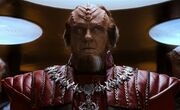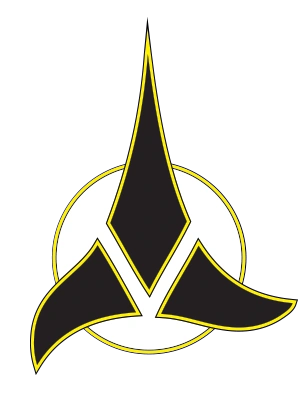The Klingon Empire (also sometimes referred to as the Imperial Klingon Empire) is the official government of the Klingon race, founded approximately 1,500 years ago (1,000 years by the Klingon calendar) by Kahless the Unforgettable, who first united the Klingon homeworld of Qo'noS. Since then the Klingon Empire expanded its sphere of influence by conquering numerous systems and incorporating them in the Empire. (See also: List of mentioned Klingon planets)
History
Like its people, the history of the Klingon Empire is violent but colorful. Around the year 900 CE, Qo'noS was ruled by Molor, a tyrannical ruler who was generally unpopular among the people. Kahless emerged as a champion of the people, and slew Molor in single combat using the first Bat'Leth. (See Sword of Kahless.) This event continues to be celebrated in the Empire in the Kot'baval Festival. (TNG: "Firstborn") Kahless ruled together with his wife, the Lady Lukara, as Emperor of Qo'noS, despite the fact that he was not of noble birth. (Qo'noS had an established nobility even at this point in its history.)
Kahless was not just a warrior, but also a philosopher of sorts. During his rule, he established a strict warrior code that was adopted into Klingon tradition and culture. His words are frequently invoked by warriors about to enter battle. Among his sayings are, "A leader is judged not by the length of his reign but by the decisions he makes." (DS9: "Tacking Into the Wind")
Over the next thousand years, the Klingon Empire would slowly expand, despite a devastating conquest and sack by the Hur'q, a powerful race from the Gamma Quadrant. The Hur'q did not stay long, however, either because of their nomadic way of life or because of fierce resistance from the Klingons — but they did not leave before taking many valuable cultural treasures, including the revered Sword of Kahless.
By the 22nd century, the Klingons were a major regional power, holding several dozen star systems and fielding a formidable military, the Klingon Defense Force.
First Contact with Earth
In the late 2140s and early 2150s, the Klingons were engaged in a fierce internal struggle that, while not amounting to actual civil war, threatened to become a more intense conflict. Numerous attacks had taken place throughout the empire that were blamed on various Klingon factions; it was not realized at the time that the attacks had actually been launched by the Suliban Cabal, who were taking orders from a mysterious individual who was an operative in the Temporal Cold War.
Although the Klingons had had occasional contact with the Vulcans prior to 2151, they had not met Humans until a courier named Klaang crashed on Earth while pursued by two Suliban soldiers. After dispatching his two pursuers, Klaang was shot by a frightened local farmer named Moore. Although Vulcan ambassador Soval advised that they withhold medical treatment and allow Klaang to die, but Captain Jonathan Archer intervened and insisted on returning Klaang to Qo'nos aboard his ship, the Enterprise (NX-01).
Archer, however, did not understand the complexity or importance of Klingon tradition, and did not realize that returning Klaang to Qo'noS was a grave dishonor and insult. However, Klaang carried with him proof that the attacks were in fact launched by the Suliban, which averted a civil war. For this service, Archer and his ship were allowed to leave peacefully. However, the incident did not leave Klingons kindly disposed towards Humans. (ENT: "Broken Bow")
In early 2153, the Empire again encountered the Enterprise when the Human ship rescued a Rha'daran refugee ship that was attempting to flee Klingon territory. Captain Archer chose to render assistance to the refugees, but failed to realize the ramifications of his actions, particularly the embarrassment he would cause the Klingons. When the Klingons demanded that the refugees be handed over for trial, Archer refused to comply. Captain Duras of the IKS Bortas intercepted the Enterprise and attacked it, unsuccessfully. Archer was later captured and brought to trial on Narendra III, a Klingon colony, for being an "enemy of the state." In an incendiary tribunal, Archer's "interference" with Klingon affairs earned him a life sentence to Rura Penthe. However, Archer managed to quickly escape from the prison, further embarrassing the Klingons. (ENT: "Judgment")
The Klingons launched several further attempts to recapture Archer, including hiring bounty hunters (ENT: "Bounty") and sending Duras himself to track the Enterprise and recapture Archer. However, Duras was unsuccessful in three different attacks against the Enterprise, and he was finally killed when the Enterprise destroyed his ship during the third attack on the edges of the Delphic Expanse. (ENT: "The Expanse")
- As of the time of this writing, the situation with the Klingons and the Enterprise remains unresolved. We will have to wait and see if the show's fourth season provides more information about the Klingons.
- Author's Note: Based on dialogue from the Star Trek movies and The Next Generation, it was originally believed that First Contact between the Federation and the Klingon Empire took place around 2218 (TOS: "Day of the Dove"), and immediately led to the state of cold war that lasted until the events of Star Trek VI. Most notable was a reference to the first contact with the Klingons in TNG: "First Contact", which implied that the events of that "disastrous" meeting directly caused decades of near-warfare. However, all this speculation has been contradicted by events seen on Enterprise.
Cold war
By the 23rd century, the Empire and the new United Federation of Planets, founded by an alliance between Earth, Vulcan, and Andoria, were engaged in a tense cold war. The Federation was quickly expanding, and its territory began to approach that of the Empire. Disputes over ownership of various star systems arose, particularly over worlds such as Donatu V, Sherman's Planet, the Archanis Sector, and Organia. Although numerous skirmishes were fought between the Federation Starfleet and Klingon forces during this time, both sides refrained from committing to open warfare.
However, in 2267 negotiations between the two sides broke down, and the Federation officially declared war against the Empire. The Klingons launched an immediate offensive, seizing several planets including the strategically important Organia. Unexpectedly, the Klingon-Federation War was brought to a sudden conclusion just days after it had begun when the Organians, a race of massively powerful noncorporeal beings, intervened and forced both sides to end hostilities. The Treaty of Organia was then imposed, establishing a neutral zone separating the two powers and establishing a procedure, to be overseen by the Organians, through which planets along the border could be claimed and settled by both sides. (TOS: "Errand of Mercy", "The Trouble with Tribbles")
A number of skirmishes and hostile encounters occurred over the next decade, including encounters at Capella IV, Tyree's Planet, and Elas in which the Klingons tried to gain strategic advantage and secure mining rights for valuable minerals such as dilithium. (TOS: "Friday's Child", "A Private Little War", "Elaan of Troyius")
In 2268, the Klingons entered into a brief and ill-advised alliance with their long-time blood enemies, the Romulans. This alliance included a technological exchange, in which the Klingons received cloaking technology in trade for D7-class battlecruisers. (TOS: "The Enterprise Incident") The alliance came to a quick and violent end with the Battle of Klach D'Kel Brakt in 2370. (DS9: "Blood Oath")
- The terms of the treaty are partially speculation, but based on the fact that the Klingons were using cloaking devices and ships called birds-of-prey in Star Trek III. The significance of Klach D'Kel Brakt is in part speculation, but based on the timing (a century before the episode), seems to fit the background as a celebrated battle between the Klingons and the Romulans.
A brief but ultimately unsuccessful thawing in relations occurred in that same year between the Federation, the Klingon Empire, and the Romulan Empire, with the founding of a jointly-managed colony on Nimbus III. Dubbed the "planet of galactic peace," the colony quickly became an embarrassing failure for all three governments, although regular meetings between representatives did take place at the colony for at least the next 20 years. (Star Trek V: The Final Frontier)
Tensions between the Klingons and the Federation again came to a head in the 2280s with the revelation of the secret Project Genesis, a scientific program developing an advanced method of quickly terraforming worlds — but a method which also had great potential for causing destruction. The Klingons sent a bird-of-prey to secretly obtain the secrets of the Genesis Planet, while at the same time negotiating openly with the Federation. The Klingons planned to accuse the Federation of duplicity in developing Genesis as a weapon of awesome power and using the negotiations as a cover. (Star Trek III: The Search for Spock) However, when the crew of the USS Enterprise, commanded by James T. Kirk, managed to capture the bird-of-prey, the Klingon ambassador proclaimed a vendetta against Kirk, vowing, "there will be no peace as long as Kirk lives!" (Star Trek IV: The Voyage Home)
Détente and peace
Although negotiations had proceeded intermittently since the imposition of the Organian Peace Treaty, no major progress was made in establishing any firm relationship between the two powers. The most notable meeting, however, was a summit at the Korvat colony in 2289 in which Federation mediator Curzon Dax met with Kang. No lasting agreement was reached at this meeting, but Dax did manage to gain grudging respect from the Klingons and established a lasting rapport. (DS9: "Blood Oath")

Chancellor Gorkon raises a toast.
The situation abruptly changed with the explosion of the Klingon moon of Praxis in 2293. The disaster caused major problems for the Klingon economy and military, as well as a major ecological crisis on Qo'noS itself. The Chancellor of the Klingon High Council, Gorkon, took the controversial move of proposing a full peace treaty and establishing a process for dismantling the military fortifications and outposts along their mutual border — the military emplacements and warships that the Klingons could no longer afford.
However, peace would not come easily. While en route to a meeting with the Federation president on Earth, Gorkon was assassinated by Starfleet conspirators from the USS Enterprise-A, who were working in cooperation with Klingon counterparts who also opposed any peace treaty between the two enemies. Gorkon's daughter, Azetbur, was appointed as the new chancellor in her father's place, and despite enormous pressure from her advisors to abandon the peace initiative, she chose to press forward and see her father's vision fulfilled. The ensuing Khitomer Conference resulted in the signing of the Khitomer Accords, a treaty which became the foundation for peace between the Federation and the Klingon Empire. (Star Trek VI: The Undiscovered Country)
Civil war
See also: Klingon Civil War
Renewed hostilities
The Dominion War
See also: Dominion War
Politics
Culture
See also:
- List of Klingon planets
External links
- Klingon Imperial Diplomatic Corps — an extensive site with detailed information about Klingon history and culture.
- Klingon Language Institute — the site to visit for instructions on how to write and speak the Klingon language.

